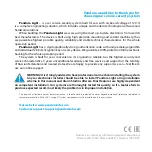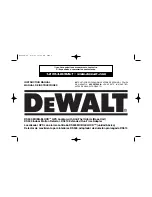
©
AirSense Technology. 2008
Page 7
Stratos-Nano
• INSTALLER’S HANDBOOK • Iss. 1
no excessive amounts of cable overflowing from the cable area. All cables should be
kept within this area, and no cables should be routed to run over the top of any of the
circuit boards.
It may be desirable for one of the cables to enter the bottom of the detector. This can
be useful if the PSU is positioned below the detector. If this is to be done, the cable
entry should be carefully drilled out prior to fitting the detector to the wall, and a gland
should be fitted. When the detector is installed, the wiring should be run along the
cable duct provided at the left-hand side of the detector and into the cable area before
being terminated at the screw terminals. Care should be taken to ensure that access to
the front cover screw is not impeded by the PSU.
The Stratos-Nano is designed to be easy to install and commission. A single switch
bank is all that needs to be set up to configure the detector.
The switch functions are as follows:
1-2. Alarm factor
Off, Off = 3, On, OFF = 4, Off, On = 5, On, On = 6 (see note 1)
The lower the Alarm Factor the higher the sensitivity of the detector. In applications
with a large amount of background dust and smoke, it is often better to reduce the
sensitivity to reduce the chances of nuisance alarms.
3. Fix alarms
Off = set by ClassiFire, On = fixed (adds 8 to alarm factor)
Setting this switch stops the ClassiFire system from modifying the alarm thresholds
after an initial 15-minute period. This bye-passes the filter contamination
compensation and the fine-tuning of the alarm thresholds to the environment.
4-5. Flow limit offset
Off, off = 3, On, Off = 6, Off, On = 20, On, On = 45) see
note 2.
These switches set the sensitivity of the Airflow monitoring system. In areas with a
tightly controlled, stable air pressure then 00 can be used to give high sensitivity to
flow variation. In less controlled environments a higher flow limit offset should be used
to avoid nuisance Fault reports.
6. Flow delay (sec)
Off = 240, On = 30
This sets the time for which a flow fault must be present before it is reported. 0 gives
better immunity to nuisance fault reports, but 1 gives faster flow fault response.
7. Input select
Off = power monitoring, On = ClassiFire override
If this switch is set to 0 then the input terminals are used for power supply monitoring.
In this configuration, opening a link between the input terminals will cause the
detector to indicate a Fault. If the switch is set to 1, then linking the input terminals
will reduce the sensitivity of the detector. This is useful if it is known that certain
normal event are likely to cause an increase in background smoke or dust. (eg opening
an oven door). A remote switch can be used to desensitise the detector.
4. Configuration






























